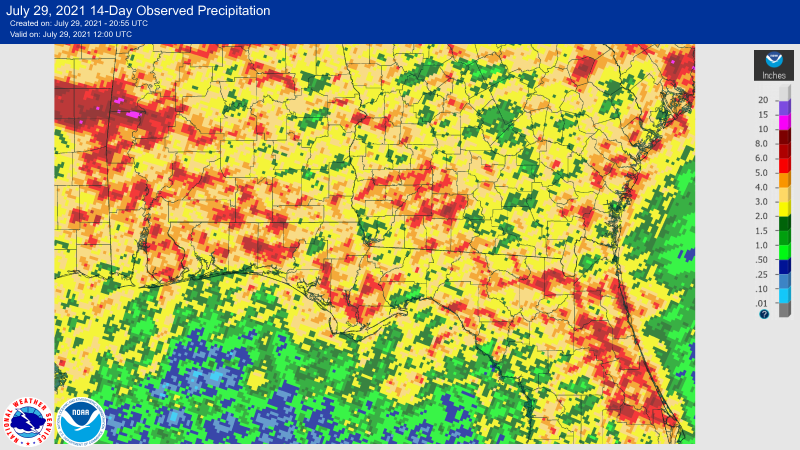Mark Mauldin, Ag & Natural Resources Agent Washington County, Ethan Carter, Regional Crop IPM Agent, Dr. Barry Tillman Peanut Breeder UF/IFAS NFREC, and Camila Ichazo
Since the last update, two weeks ago, fields have dried out somewhat allowing for the resumption of field activities previously halted by saturated conditions. This is fortunate since both insect and fugal pests appear to be on the rise throughout the peanut producing region of Florida.

It’s certainly not dry but rains have lessened considerably over the last two weeks throughout the peanut producing region of Florida. https://water.weather.gov/precip/
–
Earlier in the season growers faced unusually high numbers of tobacco budworms, but now fall armyworms appear to be the most imminent threat, with soybean loopers and velvetbean caterpillars likely to be close on their heels. Armyworm numbers are very high throughout the Southeast, but locally they have not not been an issue in peanuts, yet. It is crucial to scout fields frequently and spray when warranted, but be sure to consider which specific pests are present and at what stage of maturity. Also, at this point in the season, when there is likely some level of pest pressure in every field, it is important to use thresholds for making treatment decisions.
The following are Dr. Mark Abney’s comments regarding thresholds for foliage feeding caterpillars in peanuts:
“The threshold is an average of 4 to 8 caterpillars per row foot across 10 randomly selected locations in a field (sample 3 feet of row at each location). Use the lower end of the threshold when plants are small or stressed and the higher end of the threshold when the vines are rank and/or rapidly growing. Spraying caterpillars when populations are below threshold provides no value to the grower.”
Remember that soybean loopers are not controlled by pyrethroid insecticides, so it’s important to know which of caterpillars are in your fields. There have also been reports this summer of control failures when pyrethroids were applied to fall armyworms. Additionally, in specific areas common caterpillar control products are in short supply, due to the exceptionally high number of pests present in the region. Scout often and plan accordingly.
–
Fungicide programs should be in full swing by now, but it is still important to scout fields for the presence of fugal pathogens. Leaf spot and white mold are certainly present, and the weather is perfect for them to spread rapidly. Monitor fields closely and stay ahead of the fungal pressure that we know is coming if left unchecked.
Below is a link to a crop disease update provided by Dr. Bob Kemerait. The update was released over a week ago when field conditions were wetter, but the information is still excellent, especially if wet conditions severely disrupted your normal/planned spray schedule. The key points from Dr. Kemerait’s update were:
1) Get a good fungicide or tank-mix of fungicides on as quickly as possible.
2) Get as good coverages as you can.
3) Recognize disease is likely already active in the field, so be aggressive in your choice of fungicide and ensure there is both curative and protective activity.
Use the following link to read the full July 19 crop disease update:
2021 Row Crop Disease Update 19 July
–
aGDD Tracker for the Florida Peanut Producing Region – 7/29/21 edition
The aGDD Tracker is compiled from data generated by PeanutFARM.org.
The dark blue bars in the cells with the aGDD values indicates progress towards 2500 aGDDs. The extends to the right as aGDDs are accumulated. The entire cell will be dark blue when a field has accumulated 2500 aGDDs.
It is recommended that fields be sampled and exact days-to-harvest be determined via pod-blasting once a field reaches 2300 aGDDs.
When we published the last Tracker, on 7/16/21, I did some quick math and predicted that some of the earliest planted fields represented on the Tracker would have reached 2300 aGDDs by today. While I would have enjoyed pointing out that my prediction was correct, it is probably more valuable to point out that my prediction was wrong. The whole mindset behind the Tracker is to use data, not guesses. The technology available through PeanutFARM does a good job of identifying physiological maturity of a peanut crop, but the data being used to generate the Tracker is generic (not field specific). This makes sampling and evaluating the maturity of individual fields essential to precisely identify optimum harvest dates. As we move towards harvest season, continue to rely on data to assist you with optimizing your harvest timing, don’t leave money in the field.
Use the Tracker to approximate how your fields are progressing by following the fields on the Tracker that are the most similar to yours in terms of planting date, location and irrigation status. For more precise tracking of your fields got to PeanutFARM.org and set up your fields in the system. You will be able to enter field specific rainfall/irrigation data and soil type. Temperature data will come from the closest FAWN weather station.
–
- Peanut Maturity Update – 10/9/25 - October 10, 2025
- Fall Can be a Great Time for Vegetation Management - October 3, 2025
- Peanut Maturity Update – 9/25/25 Edition - September 26, 2025

